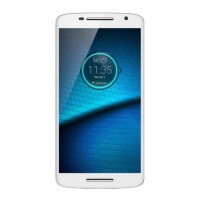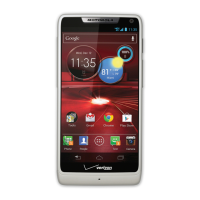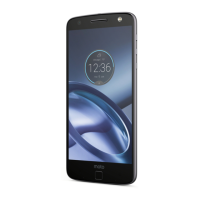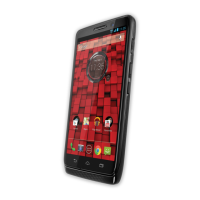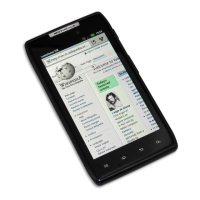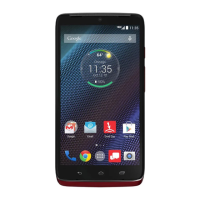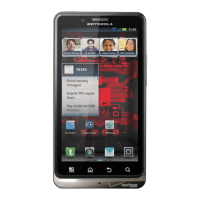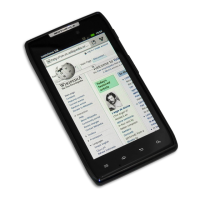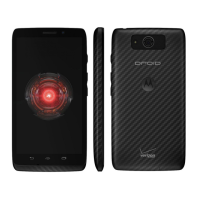
Do you have a question about the Motorola Droid Maxx and is the answer not in the manual?
| Display | 5.0 inches |
|---|---|
| RAM | 2 GB |
| Storage | 32 GB |
| Rear Camera | 10 MP |
| Front Camera | 2 MP |
| Battery | 3500 mAh |
| Network Technology | GSM / CDMA / HSPA / EVDO / LTE |
| Announced | 2013, July |
| Status | Discontinued |
| Dimensions | 137.5 x 71.2 x 8.5 mm (5.41 x 2.80 x 0.33 in) |
| Weight | 167 g (5.89 oz) |
| SIM | Micro-SIM |
| Display Type | Super AMOLED capacitive touchscreen, 16M colors |
| Display Resolution | 720 x 1280 pixels, 16:9 ratio (~294 ppi density) |
| Protection | Corning Gorilla Glass |
| CPU | Dual-core 1.7 GHz Krait |
| GPU | Adreno 320 |
| Memory Card Slot | No |
| Video | 1080p@30fps |
| Loudspeaker | Yes |
| 3.5mm jack | Yes |
| Bluetooth | 4.0, A2DP, LE, EDR |
| GPS | Yes, with A-GPS, GLONASS |
| NFC | Yes |
| Radio | No |
| USB | microUSB 2.0 |
| Sensors | Accelerometer, gyro, proximity, compass, barometer |
| Talk Time | Up to 48 h (3G) |
| Colors | Black |
| Processor | 1.7 GHz dual-core |
| Operating System | Android 4.2.2 |
| Display Size | 5.0 inches |
| Chipset | Qualcomm Snapdragon S4 Pro |
| Main Camera Features | LED flash |
| WLAN | Wi-Fi 802.11 a/b/g/n, dual-band, hotspot |
Introduces the DROID MAXX with its performance and design features.
Provides tips for starting the phone and understanding the low battery LED.
Instructions for inserting the SIM card and charging the smartphone.
Provides tips on SIM tray and power/sleep key usage.
Offers advice on reducing battery consumption by managing Wi-Fi, Bluetooth, GPS, and display brightness.
Guides users through the setup wizard and Google account registration process.
Instructions for transferring data using Motorola Migrate app.
Mentions continuing phone usage during migration and migrating later.
Introduces the home screen as the starting point for exploring apps.
Describes how to view all apps and widgets by tapping Apps.
Details how to resize widgets by touching, holding, and dragging.
Instructs users on how to access help resources for tutorials and support.
Explains how to use the Google Search box for text or voice searches.
Guides users to train the smartphone to recognize their voice via Touchless Control.
Explains icons on the left of the status bar for messages/events.
Lists icons indicating network strength, Wi-Fi, Bluetooth, GPS, etc.
Details connecting the smartphone to a computer for call, contact, and message management.
Provides the path to access Motorola Connect settings.
Details the process of disabling or uninstalling apps.
Guides users to check apps consuming the most data via Settings.
Highlights the use of touch gestures and keys for navigation.
Explains accessing quick settings via the status bar for common controls.
Describes unlocking the screen using patterns, PINs, or facial recognition.
Explains the use of volume keys for ringer, earpiece, and media.
Guides on using voice entry for text messages, including punctuation.
Guides on choosing ringtones or notifications via Settings.
Introduces Motorola Assist for automating tasks like replying to texts while driving.
Explains accessibility features for enhanced usability.
Introduces voice commands for dialing, browsing, and sending texts.
Explains how to make a call by dialing or swiping left.
Describes the screen going dark during calls to avoid accidental touches.
Explains how to view, call, text, or store recent calls.
Instructs on creating a new contact.
Guides on editing or deleting existing contacts.
Guides on creating and managing contact groups for faster access.
Instructs on creating a new message and attaching pictures, videos, or files.
Explains using voice input for messages.
Guides on checking email, sending responses, photos, and websites.
Explains adding Gmail and other email accounts via Settings.
Explains entering text by tapping or tracing letters.
Explains how to cut, copy, and paste text content.
Introduces connecting via Google+ for sharing thoughts and photos.
Guides on uploading photos to Google+ from the gallery.
Guides on navigating to a webpage by entering the address.
Guides on bookmarking and accessing webpages in the browser.
Explains incognito browsing and clearing browser data.
Introduces taking photos with Quick Capture using wrist gestures.
Explains focusing, slow motion, panorama, and geo-tagging.
Explains viewing and sharing photos/videos from the gallery.
Explains controlling music playback from the home screen or hiding the player.
Guides on turning pages and accessing book features.
Guides on finding an address and getting directions to a place or address.
Guides on saving and viewing saved addresses.
Explains receiving spoken turn-by-turn directions via Google Maps Navigation.
Introduces connecting accessories, computers, and networks.
Guides on connecting Bluetooth devices like headsets and keyboards.
Explains how to connect to Wi-Fi networks.
Provides options for viewing and managing mobile data usage.
Introduces NFC for instant sharing of content by touching devices.
Guides on mirroring the smartphone screen to an HDTV wirelessly.
Provides the navigation path to Wireless display settings.
Highlights Screen lock as the primary protection method.
Guides on using facial recognition to unlock the smartphone.
Guides on setting a SIM card PIN for startup.
Explains Google account backup for contacts, events, and other data.
Guides on selecting data for Google account synchronization.
Explains rebooting the smartphone if it becomes unresponsive.
Provides warnings and guidelines for safe battery usage and handling.
Lists crucial safety guidelines to follow while driving.
Offers advice to reduce eyestrain and avoid potential health issues.
States compliance with FCC Class B digital device limits for interference.
Strongly advises against altering the operating system due to potential damage.
States warranty applicability and lists items/conditions not covered.
Excludes all software, provided 'AS-IS' without warranty.
Limits Motorola's liability for damages, including indirect or consequential.
